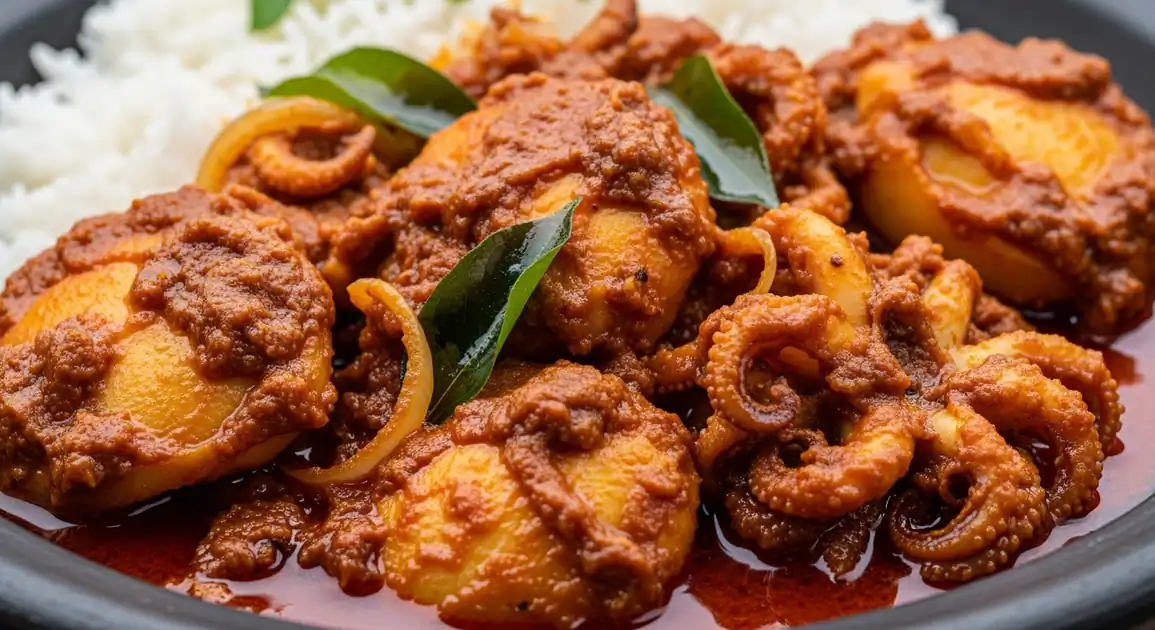Cuttlefish Curry (Dallo Kariya)
දැල්ලෝ කරිය

Description
Cuttlefish Curry is widely available throughout Sri Lanka, particularly popular in coastal regions where fresh seafood is abundant. It's a common component of the traditional 'rice and curry' meal found in local eateries ('kade'), restaurants, and homes.
Dietary Information
Serving information
Serving style
Served hot as one of several curries accompanying steamed rice. Traditionally eaten with the right hand, mixing curry and rice.
Quick facts
Lunch: 11:30 AM - 3 PM. Dinner: 6 PM - 10:30 PM.
Safety Tips
What to Look For
-
Curry served piping hot
Ensures the dish is freshly cooked or properly heated, killing potential bacteria.
-
Fresh smell and appearance of cuttlefish
Before cooking, cuttlefish should smell like the sea. In the curry, it should look tender and opaque. Avoid any ammonia or strong 'fishy' smell.
-
Reputable restaurant/vendor known for seafood
Choose places with good reviews or local reputation for handling fresh seafood correctly.
-
Clean dining environment and serving utensils
Good general hygiene practices reduce the risk of contamination.
What to avoid
-
Curry that is lukewarm or cold
Potentially unsafe temperature for bacterial growth.
-
Cuttlefish that smells off, looks discolored, or feels slimy (before cooking)
Indicates spoilage and is unsafe to eat.
-
Rubbery or tough cuttlefish in the curry
While not strictly a safety issue, it indicates overcooking or poor quality/freshness.
-
Establishments with poor hygiene standards
Increases the risk of foodborne illness from various sources.
Price information
Price range
Budget tips
- Local eateries ('kade') outside main tourist hubs offer the most affordable prices.
- Ordering it as part of a set 'rice and curry' meal is often good value.
- Prices in tourist-focused restaurants will be significantly higher.
Value indicators
- Tender cuttlefish (not rubbery).
- Rich, flavorful gravy.
- Generous portion size.
- Fresh ingredients used in the curry base.
Where to Find This Dish
Coastal Towns
Abundant in restaurants and eateries all along the Sri Lankan coastline (e.g., Negombo, Galle, Mirissa, Trincomalee).
Beachside restaurants, Local town eateries
Lunch, Dinner
City Restaurants
Available in restaurants serving Sri Lankan cuisine in major cities like Colombo, Kandy, etc.
Sri Lankan restaurants
Lunch, Dinner
Vendor Tips
- Specify spice preference if possible, especially in tourist areas.
- Look for places popular with locals for authentic flavor.
- Confirm freshness, particularly if ordering from a place not specializing in seafood.
How to Order
Regional Variations
-
Dallo Baduma / Thel Dala
(දැල්ලෝ බැදුම / තෙල් දාලා)
A drier preparation where cuttlefish is stir-fried with onions, chilies, spices, and often tomato, rather than simmered in a coconut milk gravy.
-
Devilled Cuttlefish
(ඩෙවල් දැල්ලෝ (Devil Dallo))
A popular spicy stir-fry, often served as a 'bite' (appetizer) with drinks. Typically includes chili flakes, onions, peppers, tomatoes, and sauces like soy sauce or ketchup.
-
White Cuttlefish Curry (Kiri Dallo)
(කිරි දැල්ලෝ)
A milder version made primarily with coconut milk, turmeric, onions, garlic, and curry leaves, with minimal or no chili powder, resulting in a pale yellow/white gravy.
-
Jaffna Style Cuttlefish Curry
(යාපනේ දැල්ලෝ කරිය)
Northern Sri Lankan preparation might use different spice blends (e.g., Jaffna curry powder) and potentially less coconut milk, resulting in a distinct flavour profile.
Cultural context
History
Seafood is fundamental to Sri Lanka's island cuisine, especially along its extensive coastline. Cuttlefish, abundant in local waters, has long been incorporated into traditional curry preparations. The methods reflect centuries of culinary tradition, blending indigenous ingredients like coconut milk and goraka with spices introduced through trade routes, resulting in the complex flavors characteristic of Sri Lankan curries.
Local significance
Showcases the island's rich seafood resources and complex curry-making traditions. A beloved staple for many Sri Lankans.
Eating customs
- Eaten with rice, usually mixed by hand.
- Consumed as one component among many dishes in a balanced meal.